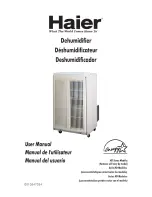
1-877-420-1330
Quest 105/155/205/ 225 Dual
Installation, Operation and Maintenance Instructions
12
www.QuestHydro.com
7.4 Refrigerant Charging
If the refrigerant charge is lost due to service or a leak, a new charge must be accurately weighed in. If any of the old charge is left
in the system, it must be recovered before weighing in the new charge. Refer to the unit nameplate for the correct charge weight
and refrigerant type.
7.5 Impeller Fan Replacement
The motorized impeller fan is a unitary assembly consisting of the motor and impeller fan. If defective, the complete assembly
must be replaced.
1. Unplug the power cord.
2. Remove the cabinet access panel.
3. Remove the screw attaching the impeller fan support bracket to the base.
4. Disconnect the impeller fan leads inside the electric box.
5. Remove fan/bracket assembly by removing 3 screws from the bracket and inlet ring assembly.
6. Remove the defective impeller fan from the bracket and replace with it with the new impeller fan.
7. Reassemble the new impeller fan by reversing the above procedure. Note: There are two pins on the backside of the cabinet
that must align with the two holes in the impeller fan support bracket.
7.6 Compressor/Capacitor Replacement
This compressor is equipped with a two terminal external overload and a run capacitor, but no start capacitor or relay
(See Figure 4).
7.6A Checking Compressor Motor Circuits
Perform the following tests if the impeller fan runs but the compressor does not with the fan switch and ventilation timer OFF and
the humidity control ON.
1. Unplug the unit; remove the cabinet side and the electrical connection cover on the compressor top.
2. Plug in the unit and turn the humidity control to ON. Check for volts from compressor terminal R to overload terminal 3 using
an AC voltmeter. If correct voltage is present, go to step 3. If no voltage, there may be a loose connection in the compressor
circuit. Test each component for continuity. See the appropriate section if a defect is suspected.
3. Unplug the unit, and then disconnect the red and yellow wires from compressor terminals R & S. Using an ohmmeter check
continuity between the points listed below.
4. Compressor terminals C and S: No continuity indicates an open start winding. The compressor must be replaced. Normal start
winding resistance is 3 to 7 ohms.
5. Compressor terminals C and R: No continuity indicates an open run winding. The compressor must be replaced. Normal run
winding resistance is .5 to 2 ohms.
6. Compressor terminal C and overload terminal 1: No continuity indicates a defective overload lead.
7. Overload terminals 1 and 3: If there is no continuity, the overload may be tripped. Wait 10 minutes and try again. If there is still
no continuity, it is defective and must be replaced.
8. Compressor terminal C and compressor case: Continuity indicates a grounded motor. The compressor must be replaced.
9. Disconnect the wires from the run capacitor. Set the ohmmeter to the Rx1 scale. The capacitor is shorted and must be
replaced if continuity exists across its terminals. If there is no needle movement with the meter set on the Rx100000 scale,
the capacitor is open and must be replaced.
10. Reconnect the wires to the compressor and capacitor. Plug in and turn on the unit. If the compressor fails to start, replace the
run capacitor.
11. If the unit still does not start, adding a hard-start kit (relay & capacitor) will provide greater starting torque. If this doesn't work,
the compressor has an internal mechanical defect and must be replaced.
Figure 15: Refrigeration System of Quest Dual Dehumidifier




































